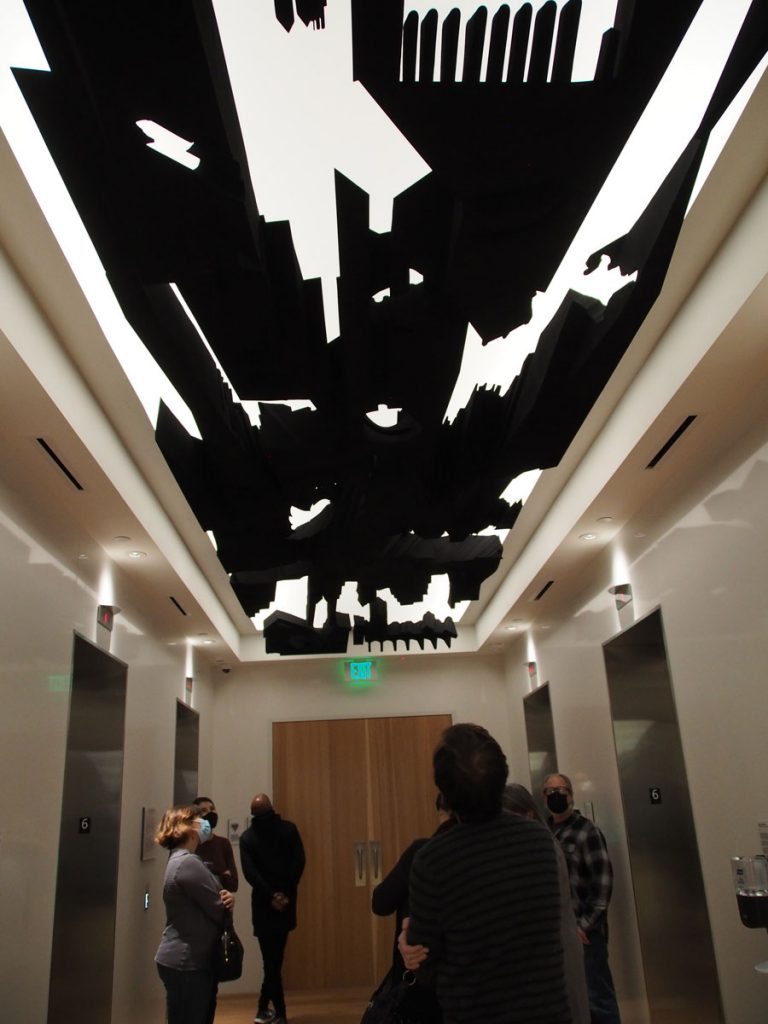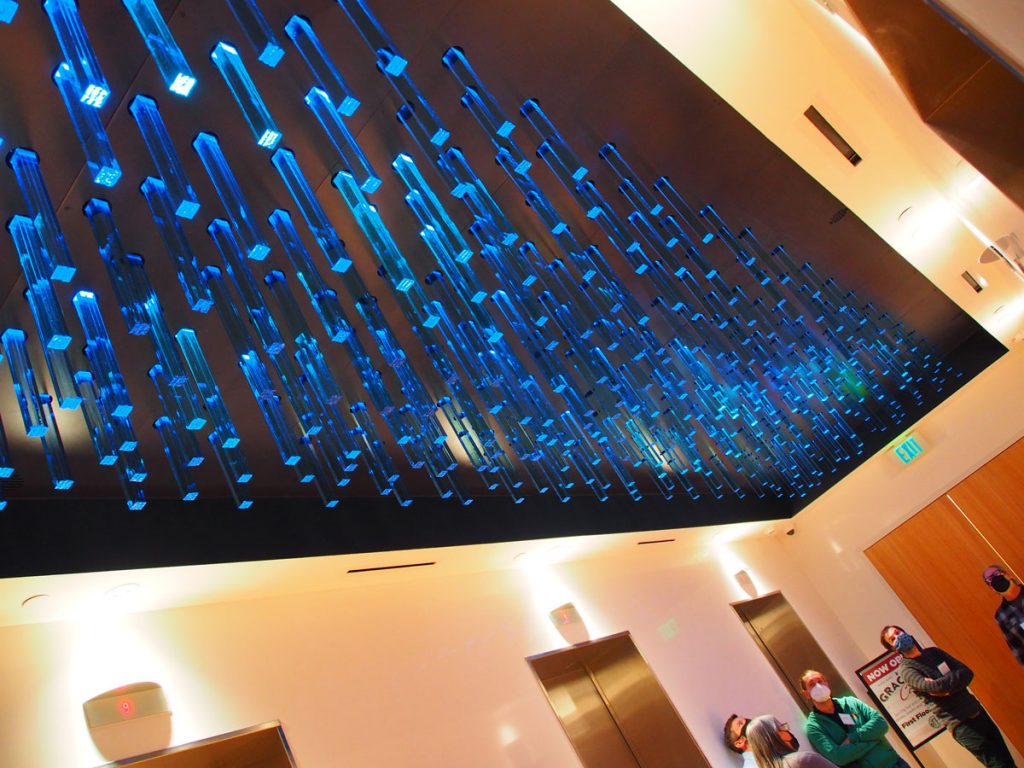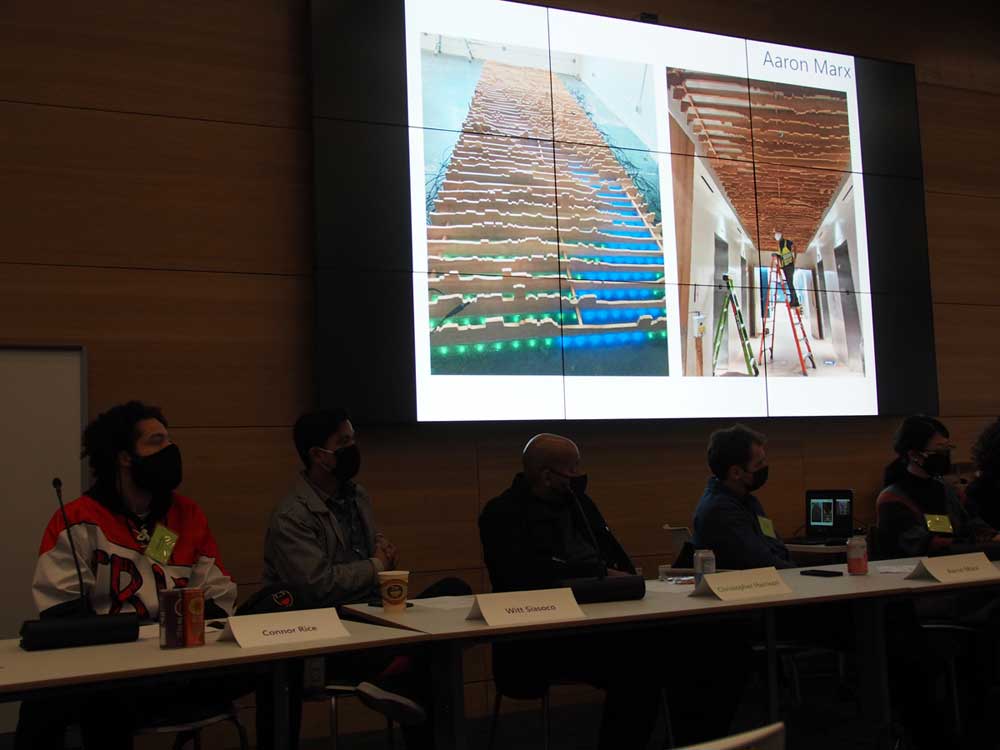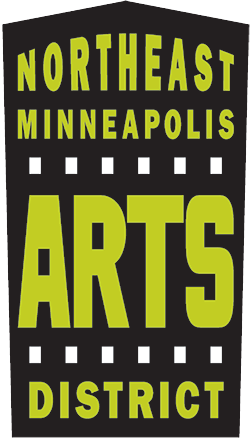Minneapolis city government set transparency and one-stop-shop goals for its new Public Service Center. Several Northeast Minneapolis-based artists helped create the environment in which 1,100 city employees will work and interact with the public toward those goals.
The building, kitty-corner from City Hall at 505 South 4th Avenue, consolidates departments that were scattered in several different service counters downtown and leased locations further away. The city hopes to recover some of the $195 million cost by selling some of its holdings such as the City of Lakes building and the former Public Service Center building.
One percent for art, $2 million, resulted in 18 different installations, seven of them the LED-illuminated ceilings of elevator lobbies. The skyway link and the 10th floor employee lounge areas are treated in bird-safe glass patterned by Futures North (Adam Marcus, Molly Reichert, John Kim). A variety of floor-to-ceiling conference room windows offer narrative vinyl murals on glass, letting in light and offering some transparency while strategically promoting confidentiality of those in meetings.
Witt Siasoco (“Power and Play”) and Kao Lee Thao (“Threads of Life”) of Northeast each made window murals.


LUCITO, the team of Andrew Lucia and Iroha Ito of Northeast, installed “Likeness of an Allegory” on one of the elevator lobby ceilings, taking inspiration from Ambrogio Lorenzetti’s “The Allegory of Good and Bad Government,” three frescos in the council chambers of the Republic of Siena’s Palazzo Publico. No photo does it justice, it has to be seen interactively. Depending on where the viewer stands, they may see 40 different silhouettes in different ways, like a Rorschach test.

Public Arts Administrator Mary Altman, conducting a tour, said that one guideline for the elevator lobbies was “that the art would reveal itself over time,” that employees coming to and from work would discover something different each day.
Artists were given just about a foot of vertical space, and the charge to work with programmable LED lights as part of the design. Michael Cohen from Schuler Schook lighting designers and Ian Adams from Gopher Stage Lighting consulted and problem-solved lighting issues with the artists.
The artists stated in a panel discussion that they had all learned a lot, from technical lighting constraints or how to generate and layer their vinyl designs to how to, in Christopher Harrison’s words, work with contractors to carry out his ideas where he was used to doing everything himself. Harrison’s studio is in the California Building.
They all spent time engaging with communities, one of their choosing and the other, with people from the department represented in their area of the building. Many expressed that they newly appreciated the workers and felt compelled to give a voice to the hidden structure of the city.

Even Northeast’s James Brenner, whose Coreten steel, glass and light sculptures grace many a city square across the country, learned something new, working indoors and solely with glass. His 340 glass columns, hanging from the ceiling of the elevator lobby outside the city’s Investigations Bureau, form mirrored convex and concave impressions referencing the scales of justice. His is the only installation that also includes sound in subtle rain, stream, or wave patterns.


In “Genesis” by Aaron Marx, formerly of Northeast, changing lights represent the seasonal flow of the Mississippi River in response to hourly changes in the river volume based on live data. The topography that hangs from the ceiling was derived from 2011 LIDAR (light detection and ranging) data to make a 1:40 scale map of the St. Anthony Falls area, rendered in wood reclaimed from ash trees infested by Emerald Ash Borer.

While it didn’t start out intentionally, as the artists worked, there developed some common themes, water and St. Anthony Falls being one. Preserving and elevating voices of Indigenous and other peoples from whom land has been withheld is another.
As visitors arrive, they’re greeted by a 26-foot-across stone rendering of the Great Seal of the City of Minneapolis from 1878 which portrays an industrial city developed by European Americans. It had been stored in a field since being salvaged from the Minneapolis Auditorium. Many of the other works throughout the building are counterpoints to that era. In particular, Marlena Myles’ series “Protecting the Generations” that appears on Level 2 near the skyway, Dakota words and their meanings: Wódakhota (harmony with all life), Wichóichage (generations/growth of the people), Wóabdeza (understanding), Wóinina (awareness of silence), Wichó’an (responsibility/way of life), and Wótakuye (relatives/kinship).
“Language without linguistics” is another theme of how the artwork may connect the citizens to the city and vice versa, said Andrew Lucia.
Connor Rice, or CRICE, was asked if he thought his work would inspire citizens to feel more empowered. “I don’t think I’ll bring about systemic change. But I hope it encourages an employee to stand up for themselves.” Witt Siasoco added, “Most of us have multiple lives. The other part of me is angry. This is optimistic.”
Contributing artists not already mentioned here include Tristan Al-Haddad, who oversaw the process of choosing artists and executed “Current Conditions,” the work in the lobby that moves throughout the day reflecting temperature and humidity; Laurie Borggreve, Angela Two Stars, Alexander Tylevich, and Rory Wakemup. Some of the art can be viewed by appointment only; most of it is visible on a self-guided tour.
Article by Margo Ashmore, reprinted with permission from Northeaster newspaper, December 15, 2021. Photos by Margo Ashmore
